

Breaking Prejudice - Microaggression Activity. Privilege Exercise. There is No Neutral on Racism and Hate: Back to School for White Educators. By Kathleen Osta, National Equity Project Last year, my colleague LaShawn Routé Chatmon and I wrote this piece in EdWeek — “5 Steps for Liberating Public Education From Its Deep Racial Bias.”
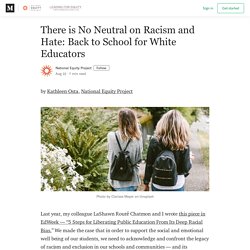
We made the case that in order to support the social and emotional well being of our students, we need to acknowledge and confront the legacy of racism and exclusion in our schools and communities — and its continued impact on all of our students. Doing so provides us with the opportunity to develop what Rob Jagers at the Collaborative for Academic Social and Emotional Learning (CASEL) calls “Transformational SEL” — engaging our young people in a critical exploration of the issues that confront them and nurturing their sense of agency to lead positive change. As we prepare to welcome students back to school it is critical that we take time to consider what has happened in the world, in the United States, and in each of our communities since our students were last with us.
A Letter to White Teachers of My Black Children — Teaching While White. Dear White Teachers of My Black Children: I am a Black mom. I know it’s sometimes hard to decide whether to say Black or African-American. I used to identify as African-American because I loved hearing the reference to my ancestral homeland in my description of myself. But then to say African-American reduces the majestic continent of Africa down to the status of a country. Africa is not a country, and so I now identify as a Black woman. I am also an educator, so I understand the deep importance of guiding and shaping all of our children.
Because I’m an educator, I know well what you — or at least the vast majority of you — learned in your pre-K-12 education and in your teacher-prep program. As a teacher, you most likely did not receive ongoing professional development about race and education in America. Because it’s unlikely that you learned about all of these things in school or in your home, it’s even more unlikely that you teach about these matters now. With love, respect, and hope, Equity vs. Equality: 6 Steps Toward Equity. I coached Jane in her third year of teaching ninth-grade English in a high school with many English-language learners (ELLs). Her style leaned toward direct instruction, and she did a great job of modeling literacy strategies.
One day, I observed Jane leading a mini-lesson on paragraph revision. As I sat beside an ELL named Veronica, I noticed that her "paragraph" was one long run-on sentence. With Veronica's permission, I made a copy of the paragraph for Jane. "Ugh! " "Well," I said, "you get to teach her.
"But we have a quiz! " "Why," I pushed gently, "does she need to take the quiz more than she needs to sit with you and learn how to structure a paragraph? " Equality vs. White Privilege McIntosh 1989. Q&A: How White Educators Can Move Beyond 'White Fragility' Commentary What educators can do to break the status quo of racism Author Robin DiAngelo thinks white people are being too sensitive.
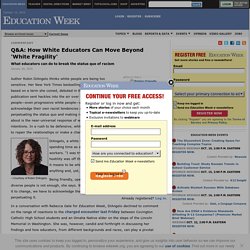
Her New York Times bestselling book, White Fragility, based on a term she coined, debuted in the summer of 2018. Its publication sent hackles into the air over the notion that white people—even progressive white people—who refuse to acknowledge their own racist tendencies are actually perpetuating the status quo and making racism worse. The “fragility” DiAngelo writes about is the near-universal response of white people to deny they harbor racist intentions. —Courtesy of Robin DiAngelo DiAngelo, a white woman, began exploring white fragility after spending time as a diversity trainer, talking primarily to white workers.
Being friendly, open minded, and surrounding yourself with diverse people is not enough, she says. A Q and A follows. Well, we only have control over our immediate selves. What does that “intentional effort” entail? An example is gender. When Zero-Tolerance Was Failing Students, This School Turned to Restorative Justice. AUSTIN, Texas — Even in elementary school, Luz Annette got into a lot of fights with other girls.
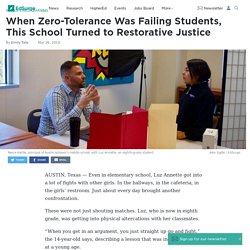
In the hallways, in the cafeteria, in the girls’ restroom. Just about every day brought another confrontation. These were not just shouting matches. Luz, who is now in eighth grade, was getting into physical altercations with her classmates. “When you get in an argument, you just straight up go and fight,” the 14-year-old says, describing a lesson that was ingrained in her at a young age. But Luz doesn’t get in fights anymore—not since the one she was involved in at the beginning of the school year, which she says was her last. At her old school, the teachers might have broken up the fight and sent her to in-school suspension—a standard disciplinary response to altercations where “they just take you to this room and then you have to be quiet and do work” for several hours, sometimes several days in a row, she says. Dear White Teachers: You Can't Love Your Black Students If You Don't Know Them. Commentary —Getty Why loving "all" students isn't good enough By Bettina L.
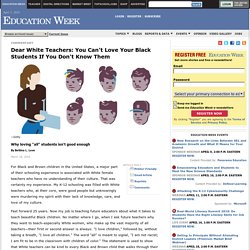
Love For Black and Brown children in the United States, a major part of their schooling experience is associated with White female teachers who have no understanding of their culture. Fast forward 25 years. "I do not think White teachers enter the profession wanting to harm children of color, but they will hurt a child whose culture is viewed as an afterthought. " Implicit Bias 101: An Introduction. Like everybody else, I possess unconscious biases about people that are contingent on how they talk and look.
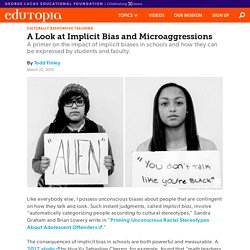
Such instant judgments, called implicit bias, involve “automatically categorizing people according to cultural stereotypes,” Sandra Graham and Brian Lowery write in “Priming Unconscious Racial Stereotypes About Adolescent Offenders.” The consequences of implicit bias in schools are both powerful and measurable. A 2017 study by Hua-Yu Sebastian Cherng, for example, found that “math teachers perceive their classes to be too difficult for Latino and black students, and English teachers perceive their classes to be too difficult for all non-white students.” Cultivating Equity In The Classroom. Why Restorative Justice Is About More Than Reducing Suspensions.